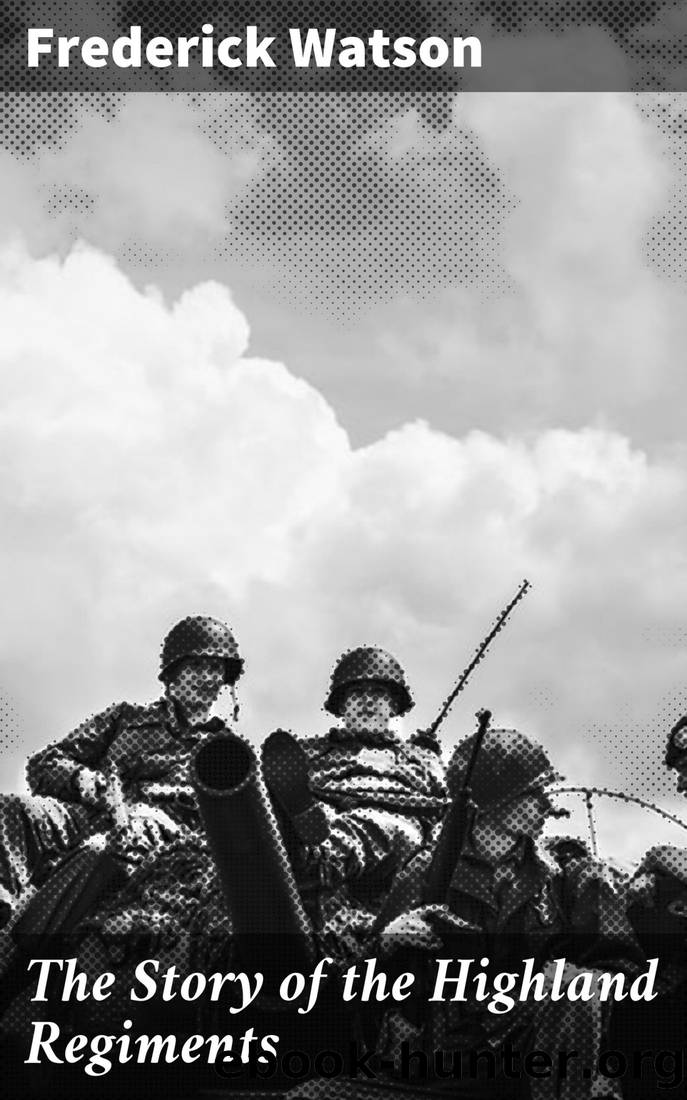The Story of the Highland Regiments by Frederick Watson

Author:Frederick Watson [Watson, Frederick]
Language: eng
Format: epub
Tags: Nonfiction, Reference & Language, Reference, Fiction & Literature, Classics
ISBN: 4064066134785
Google: -g1fzQEACAAJ
Goodreads: 26926683
Publisher: Good Press
Published: 2019-12-19T05:00:00+00:00
In the meantime, namely the beginning of November, troops had reached India from England, and the officer in command was Sir Colin Campbell, a name associated for all time with the stand of the âthin red lineâ at Balaclava. He was sixty-five years of age, considerably younger than Field-Marshal Roberts when he was asked by the Government to go to South Africa. But he was only too ready to start to the support of the hapless garrison. Landing at Calcutta on August 13, he reached Cawnpore on November 3, and on the 9th was already on the road to Lucknow.
Under Sir Colin Campbell were some 4700 men, a small force of cavalry, the Naval Brigade, artillery, and amongst the infantry the veteran Sutherland Highlanders. It is related that when Sir Colin passed before the ranks of the âthin red line,â preliminary to the advance on Lucknow, he cried, â93rd! You are my own lads. I rely on you to do the work.â At which a reply came, âAy, ay, Sir Colin, ye ken us, and we ken you. Weâll bring the women and children out of Lucknow, or die with you in the attempt.â
On November 12 the British had reached the Alumbagh. At this point Colin Campbell decided that he would not force his way through the narrow lanes of the city, but would take what was called the Dilkusha Parkâa property some two miles to the east of the Residency. Making that his base, he planned to attack the north of the city, forcing his way by the Secundrabagh.
In the meantime Outram had despatched particulars to Campbell regarding the plans of the city. He also sent a guide named Kavanagh. Kavanagh disguised himself as a Sepoy, and dropping out of the Residency at night, passed safely through the hordes of Sepoys, and crossing the river managed to reach the British. Never did his nerve fail him. By mistake he ran into a battery of the enemyâs guns. The slightest hesitation would have betrayed the fact that, despite his disguise, he was not an Indian. With the utmost coolness he made a great business of inspecting the guns, and thus disarming the suspicion of the Sepoy soldiers, walked on in a leisurely manner, and in due course reached the British lines. In all the history of heroism in the Mutiny it would be difficult to find a more hazardous undertaking than that of Kavanagh. He was afterwards awarded the Victoria Cross.
On the 15th Sir Colin Campbell made a feint of assaulting the extreme left, but during the night he advanced in another quarter, and by the morning was in full march upon the fortified position to his right. The Secundrabagh was a garden of considerable size, with walls 20 feet high, and reached by a narrow lane. By a dexterous movement the British guns were moved up to the top of this lane, and from thence opened fire upon the walls, and for nearly an hour the bombardment went on.
Download
This site does not store any files on its server. We only index and link to content provided by other sites. Please contact the content providers to delete copyright contents if any and email us, we'll remove relevant links or contents immediately.
The Radium Girls by Kate Moore(11921)
100 Deadly Skills by Clint Emerson(4840)
Rise and Kill First by Ronen Bergman(4701)
The Templars by Dan Jones(4627)
The Doomsday Machine by Daniel Ellsberg(4415)
The Rape of Nanking by Iris Chang(4136)
Killing England by Bill O'Reilly(3951)
Hitler in Los Angeles by Steven J. Ross(3900)
Stalin by Stephen Kotkin(3875)
12 Strong by Doug Stanton(3508)
Hitler's Monsters by Eric Kurlander(3268)
Blood and Sand by Alex Von Tunzelmann(3138)
The Code Book by Simon Singh(3073)
Darkest Hour by Anthony McCarten(3070)
The Art of War Visualized by Jessica Hagy(2943)
Hitler's Flying Saucers: A Guide to German Flying Discs of the Second World War by Stevens Henry(2714)
Babylon's Ark by Lawrence Anthony(2620)
The Second World Wars by Victor Davis Hanson(2480)
Tobruk by Peter Fitzsimons(2443)
